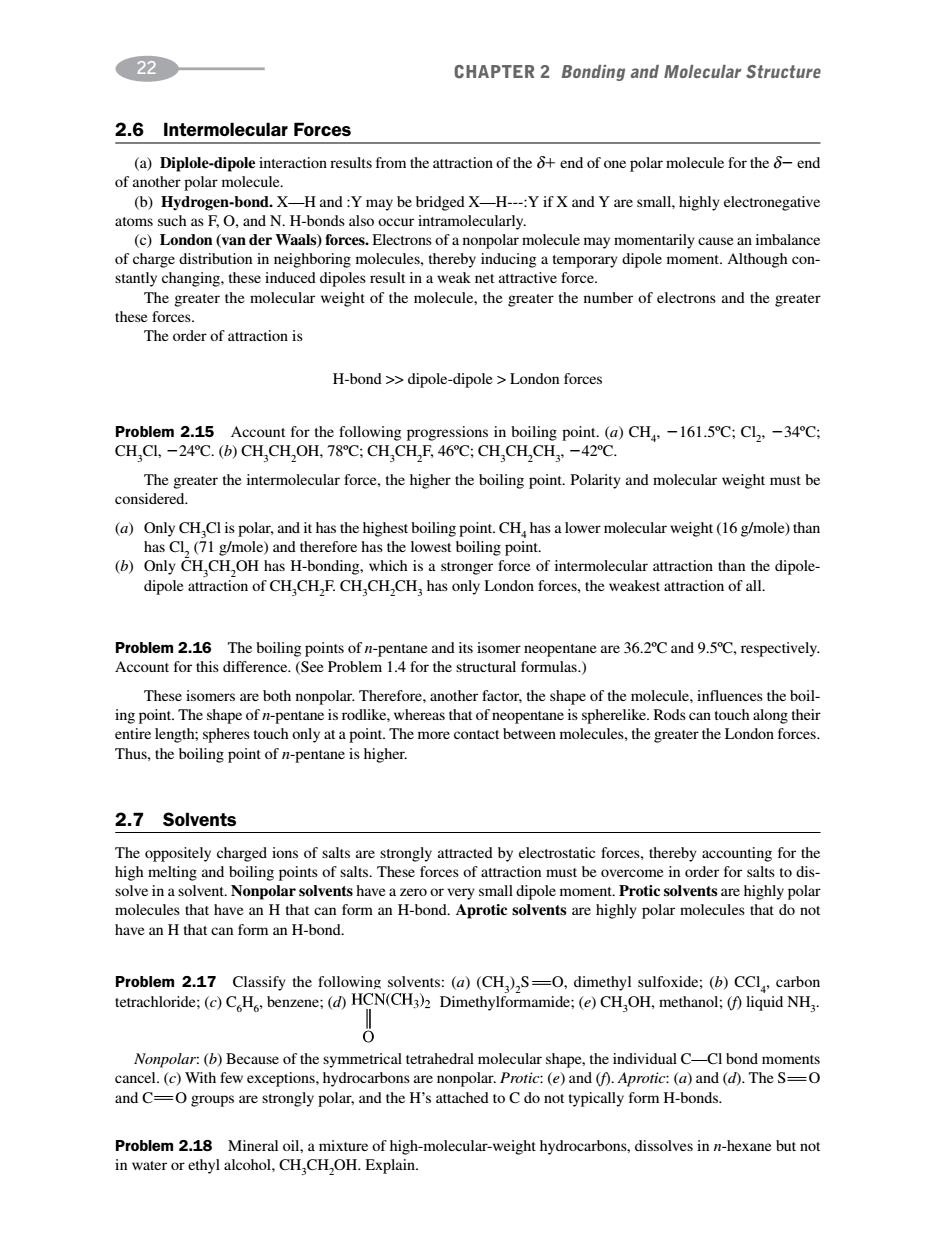正在加载图片...

22 CHAPTER 2 Bonding and Molecular Structure 2.6 Intermolecular Forces (a)Diplole-dipole interaction results from the attraction of theend of one polar molecule for theend of another polar molecule (b)Hydrogen-bond.X-H and:Y may be bridged X-H-:Y if X and Y are small,highly electronegative aloauchasROndNvHhndkloocurintnolaka (c)L on (van der wa in molecuerrry dipole momenmanc s)lorces. lectons or a non ar mol stantly changing.these induced dip The greater the molecular weight of the molecule,the greater the number of electrons and the greater these forces. The order of attraction is H-bond>>dipole-dipole>London forces unt for the following pro (a)Only CH,Cl is polar.and it has the highest boiling point.CH,has a lower molecular weight(16g/mole)than eretore has the lowe dipole a nof CH.CHF.CH,CH.CH,ha nly Lo on forces, e we nof all. Problem 2.16 The boiling oints of n-pentane and its isomer ne tane are36.2℃and9.5℃,respectively. Account for this difference.(See Problem 1.4 for the structural formulas.) Thes cule,influen r品o山uToc可a.e ces the bo .Rods can Thus.point is higher 2.7 Solvents sitely d by electros ic forces.thereby accounting for solve in a solvent.Nonpo molecules that have an H that can form an H-bond.Aprotic solvents are highly polar molecules that do not have an H that can form an H-bond. Problem 2.17 Classify the follov Nonpolar:(b)Because of the symmetrical tetrahedral molecular shape,the individual C-Cl bond moments cancel.(c)With few exceptions,hydrocarbons are nonpolar.Protic:(e)and (f).Aprotic:(a)and (d).The S=0 and C-Ogroups are strongly polar,and the H's attached to C do not typically form H-bonds. Problem 2.18 Mineral oil a mixture of high- molecular-weight hydrocarbons,dissolves in n-hexane but not in water or ethyl alcohol,CH,CH,OH.Explain. 2.6 Intermolecular Forces (a) Diplole-dipole interaction results from the attraction of the δ end of one polar molecule for the δ end of another polar molecule. (b) Hydrogen-bond. X—H and :Y may be bridged X—H---:Y if X and Y are small, highly electronegative atoms such as F, O, and N. H-bonds also occur intramolecularly. (c) London (van der Waals) forces. Electrons of a nonpolar molecule may momentarily cause an imbalance of charge distribution in neighboring molecules, thereby inducing a temporary dipole moment. Although constantly changing, these induced dipoles result in a weak net attractive force. The greater the molecular weight of the molecule, the greater the number of electrons and the greater these forces. The order of attraction is H-bond >> dipole-dipole > London forces Problem 2.15 Account for the following progressions in boiling point. (a) CH4, 161.5ºC; Cl2, 34ºC; CH3Cl, 24ºC. (b) CH3CH2OH, 78ºC; CH3 CH2F, 46ºC; CH3CH2 CH3, 42ºC. The greater the intermolecular force, the higher the boiling point. Polarity and molecular weight must be considered. (a) Only CH3 Cl is polar, and it has the highest boiling point. CH4 has a lower molecular weight (16 g/mole) than has Cl2 (71 g/mole) and therefore has the lowest boiling point. (b) Only CH3CH2OH has H-bonding, which is a stronger force of intermolecular attraction than the dipoledipole attraction of CH3 CH2F. CH3 CH2 CH3 has only London forces, the weakest attraction of all. Problem 2.16 The boiling points of n-pentane and its isomer neopentane are 36.2ºC and 9.5ºC, respectively. Account for this difference. (See Problem 1.4 for the structural formulas.) These isomers are both nonpolar. Therefore, another factor, the shape of the molecule, influences the boiling point. The shape of n-pentane is rodlike, whereas that of neopentane is spherelike. Rods can touch along their entire length; spheres touch only at a point. The more contact between molecules, the greater the London forces. Thus, the boiling point of n-pentane is higher. 2.7 Solvents The oppositely charged ions of salts are strongly attracted by electrostatic forces, thereby accounting for the high melting and boiling points of salts. These forces of attraction must be overcome in order for salts to dissolve in a solvent. Nonpolar solvents have a zero or very small dipole moment. Protic solvents are highly polar molecules that have an H that can form an H-bond. Aprotic solvents are highly polar molecules that do not have an H that can form an H-bond. Problem 2.17 Classify the following solvents: (a) (CH3)2SO, dimethyl sulfoxide; (b) CCl4, carbon tetrachloride; (c) C6H6, benzene; (d) Dimethylformamide; (e) CH3OH, methanol; (f) liquid NH3. Nonpolar: (b) Because of the symmetrical tetrahedral molecular shape, the individual C—Cl bond moments cancel. (c) With few exceptions, hydrocarbons are nonpolar. Protic: (e) and (f). Aprotic: (a) and (d). The SO and CO groups are strongly polar, and the H’s attached to C do not typically form H-bonds. Problem 2.18 Mineral oil, a mixture of high-molecular-weight hydrocarbons, dissolves in n-hexane but not in water or ethyl alcohol, CH3 CH2 OH. Explain. 22 CHAPTER 2 Bonding and Molecular Structure��������